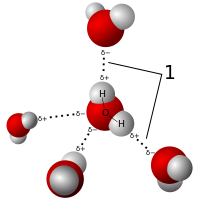
Photo from wikipedia
Stable binary complexes of RCZOH⋯CH3CHZ (R = CH3, H, F; Z = O, S) are due to contributions from the O–H⋯O/S and Csp2–H⋯O/S hydrogen bonds. The strength of Csp2/O–H⋯O is… Click to show full abstract
Stable binary complexes of RCZOH⋯CH3CHZ (R = CH3, H, F; Z = O, S) are due to contributions from the O–H⋯O/S and Csp2–H⋯O/S hydrogen bonds. The strength of Csp2/O–H⋯O is 1.5 to 2 times greater than that of the Csp2/O–H⋯S bond. The substitution of H(Csp2) of HCZOH by CH3 causes a decrease in complex stability, while the opposite trend occurs for the F atom. A very large red shift of the O–H stretching frequency in O–H⋯O/S bonds was observed. A surprising Csp2–H blue shift up to 104.5 cm−1 was observed for the first time. It is found that the presence of O–H⋯O/S hydrogen bonds and a decisive role of intramolecular hyperconjugation interactions in the complex cause a significant blue shift of the Csp2–H covalent bonds. A striking role of O compared to the S atom in determining the blue shift of Csp2–H stretching vibration and stability of binary complexes is proposed. The obtained results show that the ratio of deprotonation enthalpy and proton affinity could be considered as an index for the classification of the non-conventional hydrogen bond. SAPT2+ results show that the strength of RCSOH⋯CH3CHS complexes is dominated by electrostatic and induction energies, while a larger contribution to the stability of remaining complexes is detected for the electrostatic component.
Journal Title: RSC Advances
Year Published: 2022
Link to full text (if available)
Share on Social Media: Sign Up to like & get
recommendations!